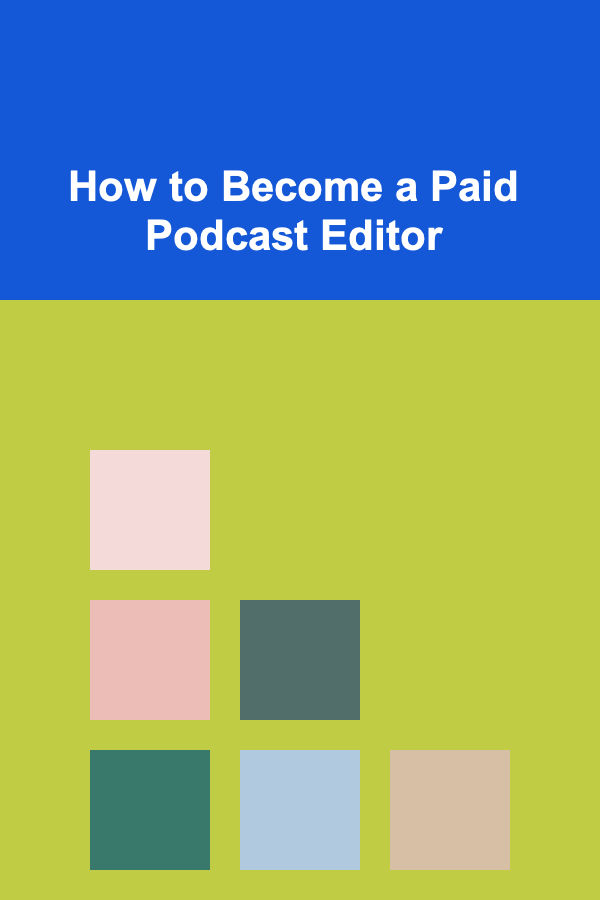
How to Become a Paid Podcast Editor
ebook include PDF & Audio bundle (Micro Guide)
$12.99$9.99
Limited Time Offer! Order within the next:

The podcasting industry is growing at an unprecedented rate, with millions of shows and episodes produced each year. As podcasts become an increasingly popular medium for storytelling, education, and entertainment, the demand for skilled professionals to help produce high-quality audio content has also skyrocketed. One of the most important roles in this process is that of a podcast editor, a crucial player behind the scenes who ensures that each episode sounds polished, engaging, and professional.
If you've ever wondered how to become a paid podcast editor, you're in the right place. In this article, we will explore the steps you need to take, the skills you must develop, and the strategies you can use to break into the world of podcast editing and get paid for your work.
Understanding the Role of a Podcast Editor
Before diving into how to become a podcast editor, it's essential to understand what the role entails. Podcast editing is a multi-faceted process that includes several key tasks, such as:
- Audio Cleanup: Removing background noise, eliminating unwanted sounds (like pops, clicks, or static), and making sure the audio is clear and easy to understand.
- Cutting and Splicing: Removing sections of audio that may be irrelevant, repetitive, or unnecessary, and seamlessly joining the remaining segments together.
- Adding Music and Effects: Incorporating intro and outro music, sound effects, and transitions that enhance the listener's experience.
- Balancing Audio Levels: Ensuring that the volume levels are consistent throughout the episode, so listeners can hear every word clearly, regardless of their device.
- Creating a Final Mix: Mixing all the elements---voice, music, effects---into a cohesive final product that sounds professional.
The Growing Demand for Podcast Editors
The explosion of podcasts in recent years has created a significant demand for audio professionals who can ensure podcasts are well-edited and sound polished. As more businesses, influencers, and content creators launch podcasts to reach their audiences, there is a growing need for skilled editors who can help make these shows stand out in an ever-competitive market.
In 2023, the number of podcast listeners surpassed 400 million globally, and the trend is expected to continue. As podcasts evolve and new genres emerge, the need for specialized editing expertise---whether it's editing true crime, news, comedy, or educational podcasts---has never been greater.
Steps to Become a Paid Podcast Editor
Becoming a paid podcast editor is not an overnight process, but with the right approach, dedication, and skill-building, it is certainly achievable. Below are the steps to follow to break into the podcast editing world and start getting paid for your work.
1. Learn the Basics of Audio Editing
Before you can start editing podcasts professionally, you must first learn the fundamentals of audio editing. This involves understanding both the technical and creative aspects of sound production. While there are many different ways to approach audio editing, the following steps will help you lay a solid foundation:
Choose Your Audio Editing Software
The first thing you need is a reliable digital audio workstation (DAW). Some of the most popular audio editing software options for podcast editors include:
- Audacity: A free, open-source program that's great for beginners. It offers all the essential features for editing podcasts, such as cutting, splicing, and noise reduction.
- Adobe Audition: A more advanced tool with a wide range of features for professional audio editing. It is a paid option but widely used in the podcasting industry.
- Reaper: Another powerful DAW with a lot of flexibility and a lower cost than Adobe Audition.
- GarageBand: For Apple users, GarageBand offers a simple, user-friendly interface with essential podcast editing features.
Regardless of which software you choose, it's essential to become proficient in its tools and functions, such as:
- Trimming and splitting tracks: Cutting audio files into smaller segments to remove mistakes, pauses, or irrelevant content.
- Noise reduction: Using built-in noise filters to remove background hums or static.
- Volume automation: Adjusting the volume of different sections of an audio track to create a balanced, consistent sound.
Understand the Audio Editing Process
Once you are comfortable with your DAW, you need to understand the process of editing a podcast episode from start to finish. This typically involves the following steps:
- Importing audio files: Upload the raw audio files into your editing software.
- Removing mistakes: Identify areas where the hosts, guests, or speakers made mistakes or where there are long pauses, and edit them out.
- Adding music and sound effects: Insert any intro or outro music, jingles, or sound effects that enhance the listening experience.
- Audio mixing: Adjust volume levels for each segment to ensure a clear, professional sound.
- Finalizing the mix: Apply any necessary EQ, compression, or mastering to ensure the podcast sounds polished and professional.
2. Develop Your Editing Skills
While learning the technical basics is a good start, you also need to hone your skills as an editor. This involves understanding the nuances of sound design, pacing, and storytelling. Here are some ways to improve your editing skills:
Focus on Listening
Good podcast editors are excellent listeners. They must be able to identify when an episode is too long, when the pacing is off, or when the flow of conversation doesn't feel natural. Listening critically to a variety of podcasts will help you develop your ear for what makes a good episode and how to edit it to improve its quality.
Master Audio Techniques
- Noise Reduction: Background noise can be a huge problem in audio, and a good podcast editor knows how to clean up audio without affecting the quality of the voices.
- Compression: A good compressor ensures that the audio is consistent and that no words are too soft or too loud.
- EQ (Equalization): EQ can help to shape the sound of a voice, making it clearer and more pleasant to listen to. Learning how to adjust midrange frequencies or cut out unwanted low-end noise is a key skill for any podcast editor.
Study Different Genres
Each podcast genre has its own editing style and requirements. For instance, editing a narrative-driven true crime podcast requires different skills compared to editing an interview-based business podcast. Study various genres to learn how different types of podcasts are structured and how their editing needs vary.
3. Build a Portfolio
Once you've acquired the necessary skills, it's time to build a portfolio to showcase your work. A strong portfolio is crucial when you're starting out, as potential clients will want to hear examples of your editing style and capabilities. Here are some ways to build and showcase your portfolio:
- Offer Free Work: When you're just starting, you may want to offer your editing services for free or at a discounted rate to build up your portfolio. Volunteer for small podcasts or work with independent creators who need editing help.
- Create a Demo Reel: Put together a short demo reel that highlights your editing skills. Choose segments from podcasts you've edited that showcase your ability to clean up audio, balance sound levels, and create a polished final product.
- Build an Online Presence: Create a professional website or online portfolio where potential clients can listen to samples of your work, read client testimonials, and learn more about your services.
4. Find Paying Clients
After building your portfolio, the next step is to find paying clients. Finding work as a podcast editor can be challenging, especially when you're starting out, but there are many platforms and strategies you can use to find gigs:
Join Freelance Platforms
- Upwork: A popular platform for freelancers where you can find podcast editing jobs.
- Fiverr: Fiverr is another great place to offer your services at various price points and get noticed by clients looking for affordable podcast editing.
- PeoplePerHour: This is another platform that connects freelancers with potential clients in various industries, including podcasting.
Reach Out to Podcasters Directly
Many independent podcasters need editing help but may not know where to look for qualified editors. Consider reaching out to podcasters whose shows you enjoy or feel you can help improve. Send them a friendly email introducing yourself and offering your editing services.
Network in Podcasting Communities
There are many online communities, such as podcasting groups on Facebook or Reddit, where podcasters seek recommendations for editors. By participating in these communities, you can make connections and gain leads for potential work. Networking is a crucial element of freelance work, so actively engage with other creators and professionals in the industry.
5. Set Your Rates and Manage Your Finances
Once you start getting paid work, it's essential to establish your rates and manage your finances effectively. Rates can vary depending on your experience, the complexity of the project, and the client's budget. Many editors charge either an hourly rate or a per-episode rate.
Determine Your Rates
As a beginner, you may want to start with lower rates to build up your client base. However, as you gain more experience, you can gradually increase your rates to reflect your expertise. Consider factors such as:
- The length of the podcast: Longer episodes typically require more editing time.
- The complexity of the edit: Some podcasts may require more extensive editing, like sound design or heavy mixing.
- The client's budget: Be flexible with your rates, but ensure you're compensated fairly for your work.
Keep Track of Your Income and Expenses
As a freelance podcast editor, you'll need to manage your finances and keep track of your income and expenses. Consider using accounting software like QuickBooks or FreshBooks to track payments, invoices, and taxes.
Conclusion
Becoming a paid podcast editor requires a combination of technical skill, creative ability, and a strategic approach to finding clients. As the podcasting industry continues to expand, there is tremendous potential for editors to carve out a niche and make a living doing what they love. By learning the basics of audio editing, honing your skills, building a strong portfolio, and networking with potential clients, you can turn your passion for podcasting into a lucrative career.

How to Analyze Your Spending Habits and Improve Them
Read More
How to Create an Organized Home Office with Limited Space
Read More
How to Make Small Rooms Feel Bigger with Lighting Techniques
Read More
How to Organize Recipes for Meal Prepping
Read More
Maximize Your Earnings: Renting Out Extra Space in Your Home Made Easy
Read More
How to Incorporate Biophilic Design into Your Home
Read MoreOther Products

How to Analyze Your Spending Habits and Improve Them
Read More
How to Create an Organized Home Office with Limited Space
Read More
How to Make Small Rooms Feel Bigger with Lighting Techniques
Read More
How to Organize Recipes for Meal Prepping
Read More
Maximize Your Earnings: Renting Out Extra Space in Your Home Made Easy
Read More